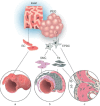Epicardium-derived cells in cardiogenesis and cardiac regeneration
- PMID: 17380310
- PMCID: PMC2778661
- DOI: 10.1007/s00018-007-6522-3
Epicardium-derived cells in cardiogenesis and cardiac regeneration
Abstract
During cardiogenesis, the epicardium grows from the proepicardial organ to form the outermost layer of the early heart. Part of the epicardium undergoes epithelial-mesenchymal transformation, and migrates into the myocardium. These epicardium-derived cells differentiate into interstitial fibroblasts, coronary smooth muscle cells, and perivascular fibroblasts. Moreover, epicardium-derived cells are important regulators of formation of the compact myocardium, the coronary vasculature, and the Purkinje fiber network, thus being essential for proper cardiac development. The fibrous structures of the heart such as the fibrous heart skeleton and the semilunar and atrioventricular valves also depend on a contribution of these cells during development. We hypothesise that the essential properties of epicardium-derived cells can be recapitulated in adult diseased myocardium. These cells can therefore be considered as a novel source of adult stem cells useful in clinical cardiac regeneration therapy.
Figures



References
-
- DeRuiter M. C., Poelmann R. E., VanderPlas-de Vries I., Mentink M. M. T., Gittenberger-de Groot A. C. The development of the myocardium and endocardium in mouse embryos. Fusion of two heart tubes? 1992;185:461–473. - PubMed
-
- Gittenberger-de Groot A. C., Bartelings M. M., DeRuiter M. C., Poelmann R. E. Basics of cardiac development for the understanding of congenital heart malformations. Pediatr. Res. 2005;57:169–176. - PubMed
-
- Kurkiewicz, T. (1909) [Zur Histogenese des Hersmuzkels der Wirbeltiere]. Bull. Int. Acad. Sci. Cracovie 148–191.
-
- Kölliker A. Entwicklungsgeschichte des Menschen und der Thiere. Leipzig: Engelmann; 1879.
-
- De Haan R. L. In: Organogenesis. De Haan R. L., Ursprung H., editors. New York: Holt, Rinehart and Winston; 1965.
Publication types
MeSH terms
LinkOut - more resources
Full Text Sources
Other Literature Sources

